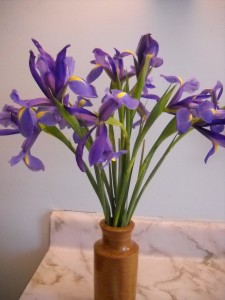Cut Flowers
Conventional wisdom has it that most cut flowers come from Central or South America, many grown using underpaid, poorly treated laborers and toxic chemicals that are banned in the United States. I decided to look into the cut flower industry, and started by reading Amy Stewart’s book, Flower Confidential. It’s a good read and very informative. I also spoke to the head of the Sun Valley Group, the number one producer of cut flowers in America.
Unlike consumers in Europe, Americans apparently don’t really care where their cut flowers were grown – or how. We care about how they look, how long they last in a vase, but mostly we care about the cost. Overall, we are cheap when it comes to buying flowers. We may pay extra for organic coffee or fair trade bananas, but flowers? Nope. We just don’t seem to care.
I spoke to retired florist Lynn Schad, who told me that when she prepared roses for bouquets she sensed that she was being exposed to toxins, and worried about it. There was nothing she could prove, but the way her hands and breathing felt after handling roses told her that there were chemicals on the roses. Strong chemicals.
Flower Confidential confirmed Lynn’s perceptions. According to the book, more than 90% of roses sold in America are grown in Ecuador or Columbia and most are dipped in fungicide, top to bottom, before they are shipped. If a fungus shows up on a rose during inspection in Miami, the entire shipment must be fumigated, destroyed, or returned to the producer. All options are costly.
But not all flowers arrive with their own coating of toxic chemicals. The florist at my local food coop is making a real effort to buy local flowers – even now, in the dead of winter. Some local growers are using greenhouses to produce lilies, tulips and other flowers, and some of them use all organic or low-toxin methods.
I phoned Lane DeVries, the President of Sun Valley Group which is based in California. They grow at least 100 million stems of cut flowers every year including iris, lilies, tulips, freesias, Gerbera daisies and others. Mr. Devries explained that his farms have taken steps to produce flowers that are grown using sustainable methods, that they use the least toxic methods to control insect and fungal problems, and that workers are being treated fairly. He believes that consumers, given a choice, will buy American flowers – and get a better product.
Mr. Devries told me that his growers are always looking for ways to reduce chemical use. They steam the soil in their greenhouses to kill fungi instead of using fungicides, for example. They recently started introducing garlic juice in the drip irrigation system in certain greenhouses to repel thrips and spider mites. Using smaller quantities of chemicals saves money, and using water more efficiently is not only ecologically sound, it’s also a cost saver.
A few other bit of information from Flower Confidential that may interest you: most commercially grown flowers have no scent, roses in particular. Breeders have created flowers that are good looking, have a long vase life and travel well – and in the process most have lost that special gift created to attract the bees (and make our hearts throb): a tantalizing scent.
Gerbera daisies, I learned, should be kept in just an inch or two of water. They absorb too much water through their stems if kept in more, and that shortens their vase life. And the book says that you can extend vase life of your roses by 2 days if you submerse them in a bathtub of cold water for 3 hours before putting them in a vase (though that may introduce chemicals into your next bath, I fear).
You probably know to cut an inch off the stems when you put them in a vase. But remember to keep doing this – regularly changing the water and cutting off a bit more stem prolongs vase life. Bacteria grow in vases, clogging stems – particularly if you don’t strip off lower leaves. Flower Confidential confirms that those packets of powder given with your flowers do help to keep flowers fresh. But, the book explains, so will a pinch of sugar and a drop of bleach.
If some flowers in a bouquet get wilted, remove them as they give off ethylene gas that will make other flowers age more quickly. And always keep flowers away from heat (the wood stove and the top of the TV), out of direct sunshine and far from any fresh apples – they emit ethylene, too.
So if you want eco-friendly flowers, ask your local florist for them. Ask for local flowers. Ask for American grown flowers – they are restricted in chemical use more than South American growers. Don’t just buy by price – low prices often mean low quality. I got some Sun Valley iris that lasted over a week – in part because they were a variety grown for long vase life, but also because they only traveled from California, not from overseas.
Lastly, think outside the box. Don’t just buy roses for special occasions. Go see a real florist and ask questions about other nice flowers. You’ll be pleased with what you can get and how long they last.
Visit Henry’s new website, www.henryhomeyer.com to learn about his new kid’s book, Wobar and the Quest for the Magic Calumet or his gardening web site, www.Gardening-Guy.com.



